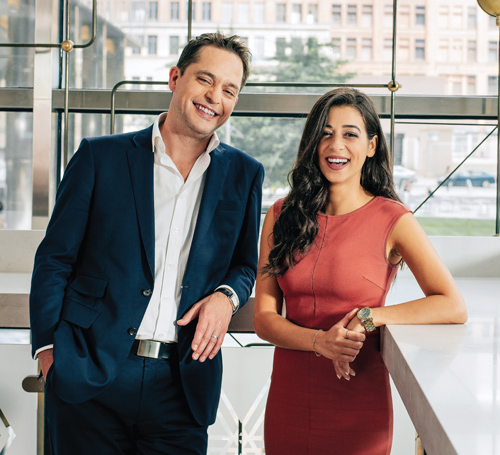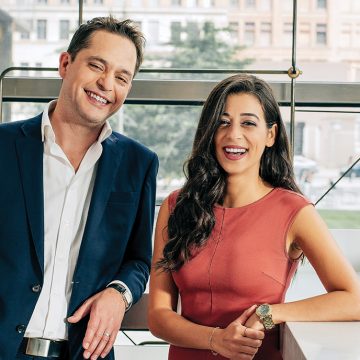Stephanie De Caria started in insolvency law before she knew what some of the terms involved in the practice area even meant. It was 2015. De Caria was a first-year associate at Fogler, Rubinoff LLP and one of the partners, Gregory Azeff, asked her to assist him on a receivership case, a core part of insolvency law that makes up a large amount of his practice.
Not wanting to reveal her ignorance, she said yes. Then she typed “receivership” into Google. That MO (step one—accept the challenge; step two—figure out what to do next) would continue to define her work. And she would continue to practise alongside Azeff.

Gregory Azeff and Stephanie De Caria often have meetings at SpeakEasy 21, one of the duo’s favourite restaurants in the downtown core. “It’s got great staff, great food and a great atmosphere,” says Azeff. “And there’s lots of tabletop room for documents during working meals.”
In its purest form, receivership law is simple. A debtor-creditor relationship goes bad, and a judge appoints a receiver — usually a bankruptcy specialist at an accounting firm — who liquidates the assets of the debtor to pay back the creditor. If the proposal makes sense, the court approves it. Case closed.
But receivership isn’t just a procedure for bankruptcies. It can help remedy a variety of different business disputes. Azeff, who is 47, had turned to De Caria, now 29, to help out on a particularly unusual receivership case. He had been retained by a financier who hoped to acquire the Kerr Addison gold mine in northeastern Ontario, a once-lucrative operation that was shuttered in the ’90s. But the owner refused to sell. And the client didn’t have an obvious claim to the property. So he went to Azeff with a simple challenge: help him acquire the mine.
Azeff had an unusual idea. He planned to convince the court to appoint a receiver who would, in turn, take control of the mine and put it up for sale. This would allow the financier to purchase it.
Both Azeff and De Caria got to work. The duo homed in on the fact that there were health hazards and environmental problems associated with the inactive mine that had not been addressed for years. After weeks of research, De Caria found an old case that established that environmental degradation could help them persuade the court to appoint a receiver.
Azeff went to court, armed with this precedent and a detailed explanation of the economic benefits of reopening the mine. In the end, he won. The judge placed the mine into receivership. And the court-appointed receiver put the mine up for sale and Azeff’s client made the highest bid.
That case defines Azeff’s practice. He tackles difficult legal problems and is willing to try things no other lawyer has done.
De Caria kept working with Azeff. And he kept throwing her seemingly impossible problems, so she could devise solutions through exhaustive research and unconventional thinking. “The great athletes always want the ball,” says Azeff. “But for a partnership to work, you’ve got to be willing to pass the ball. You’ve got to trust the other person to run with it.”
For De Caria, working with Azeff made her first years as a lawyer more exhilarating than she’d imagined they could be. But in 2017, Azeff announced his decision to move to Miller Thomson LLP, a firm with a large insolvency and restructuring practice and a presence across Canada.
De Caria was blindsided. With Azeff’s departure, she would lose not just her mentor but also her connection to the practice area she’d grown to love. “I was pretty upset, to be honest,” she says. Her first words to Azeff, however, were exactly the ones he’d hoped to hear: “Take me with you.” He was reluctant to be the person to broach this subject. (The rules governing poaching can be murky and he didn’t want to expose himself to liability.) But once De Caria had expressed interest in the job, he connected her to the hiring team at Miller Thomson. Three weeks later, she joined him there.
Today, De Caria and Azeff work in a dizzying array of industries: hotels, real estate, steel, manufacturing, tech, accounting and the non-profit sector. That element of uncertainty and intellectual curiosity is, for De Caria, what makes working with Azeff so exciting. As she puts it: “A colleague once told me that if Greg was a health lawyer, I would probably love health law just as much as I enjoy insolvency.”
This story is part of our feature on dynamic legal duos, from our Fall 2018 Issue.
Photography by Ian Patterson, hair and makeup by Michelle Calleja


